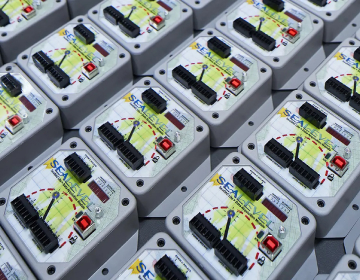
Relio R1 Rugged - Intel Atom x6414RE (Elkhart Lake)
R142-Config
We work with the most talented engineers to solve difficult problems in diverse environments. No matter your application requirements, we will provide a solution that perfectly fits your needs.
Contact UsSince 1986, we’ve brought control to the user with our innovative I/O solutions that enable computer connectivity. As our product families expand, responsive thinking and creative development continue to drive our company. From engineering design to production and support, Sealevel ensures client satisfaction with precision-made technology and high-quality services.
Learn MoreAll engineering, manufacturing, and
support take place at our ISO 9001:2015
certified facility.
Sealevel is committed to employing
American labor and maintaining our
exceptional quality standards at our SC
headquarters.
Beginning with the end in mind, our
engineering, test, quality, and
manufacturing teams collaborate from
concept to official production.
Sealevel develops cutting-edge solutions
that leverage emerging technology
rooted in intentional design.
We have a robust hardware and software engineering capabilities as well as a full line-up of services for custom projects to support industry leaders world-wide.
View All Solutions
From the earliest engineering concepts to manufacturing and support beyond shipment, the Sealevel team is on standby.
Learn More
Sealevel’s engineering team specializes in complex I/O and computing designs that incorporate manufacturability, SWAP-C2 optimization, parts traceability, and high reliability.
Learn More
Sealevel consistently exceeds customer expectations, providing innovative products to leaders in defense, public safety, unmanned systems, industrial automation, and more.
Learn More
Sealevel’s legacy is established in the industrial automation market. Today, customers are deploying our products to support test & measurement, power generation, and other applications.
Learn MoreWhat’s the best way to learn about what we do for customers? Read their stories and learn firsthand how we’re making a difference in critical communications.

An international defense prime contractor that specializes in aerospace electronic systems needed reliable, interoperable support for an avionics test system for use in the calibration of the Boeing F-15EX Eagle II.
Learn More
An international defense prime contractor that specializes in aerospace electronic systems needed reliable, interoperable support for an avionics test system for use in the calibration of the Boeing F-15EX Eagle II.
Learn More
An international defense prime contractor that specializes in aerospace electronic systems needed reliable, interoperable support for an avionics test system for use in the calibration of the Boeing F-15EX Eagle II.
Learn MoreWe provide innovative hardware and software products to industry leaders in military and aerospace, public safety, unmanned systems, industrial automation, monitoring and more.

SeaLevel’s serial, digital, and analog interfaces are specifically designed to succeed in industrial environments by providing Ethernet, USB, PCIe, PCI, and wireless connections for process automation.
Learn More
By incorporating future-proof embedded computing design, SeaLevel’s products support autonomous detection and inspection systems. To meet the requirements for unmanned vehicles, drones, and aircraft, our expertise in I/O is unmatched.
Learn More
In collaboration with hospitals, healthcare system integrators, and OEMs, SeaLevel is committed to providing solutions for complete reliability within medical operations. Our customers confidently expand legacy systems and embrace new technology across the industry.
Learn More
From complex laptop docking stations to high-speed communication adapters to SWaP-C2 optimized embedded computers for defense, SeaLevel’s electrical and mechanical design expertise delivers performance while meeting stringent MIL-STDS.
Learn More
SeaLevel’s engineering experts successfully leverage our extensive COM Express and I/O experience to deliver rugged, voltage-tolerant systems across the energy industry: oil and gas, electrical, solar, and wind.
Learn More
SeaLevel’s industrial computers, data acquisition modules, and edge hardware solutions enable continual connectivity and control, providing real-time data and actionable information for predictive maintenance.
Learn More
SeaLevel’s industrial computers and data acquisition modules are used across distributed networks for emergency call centers, firefighting control stations, and security communications to support disaster relief as well as day-to-day operations.
Learn More
SeaLevel’s standard and custom edge products offer all-inclusive solutions that enhance existing systems – enabling municipalities and companies to operate more efficiently and realize new revenue streams.
Learn More
Our high-reliability I/O solutions are incorporated in test and measurement applications while our embedded computers serve as controllers in manufacturing and deployment processes – from automotive test systems to passenger analytics to vehicle charge stations.
Learn MoreExplore our latest articles, customer stories, videos and more. Find quick access to product information including data sheets and manuals here, too.
We would like to introduce you to the best international partner for all of your Sealevel needs.
FIND YOUR CONTACT